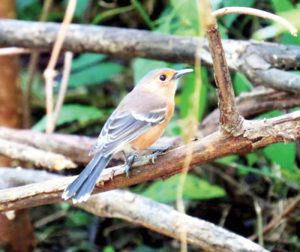Fears on fate of Tinian monarchs
The Tinian monarch is a type of bird that historically has only occurred on the island of Tinian. (DIVISION OF FISH AND WILDLIFE)

The lack of clarity in what the U.S. military plans to do on Tinian is prompting fears that a great number of Tinian monarchs may be wiped out, according to acting wildlife supervisor Jill Liske-Clark of the CNMI Division of Fish and Wildlife.
“The threat that the U.S. Fish and Wildlife Services are worried about—frankly, we’re worried about too—is we don’t really know what the military’s plans are for Tinian,” she said.
The U.S. military is in the process of revising the CNMI Joint Military Training environmental impact statement and Liske-Clark said that, based on the last proposal, it could prove harmful to the Tinian monarch, a type of bird found only on Tinian.
“If they pursue any of those options on Tinian, it was going to be significantly harmful to Tinian monarchs. They were planning to clear a lot of Tinian monarch habitat,” she said.
She said the Center For Biological Diversity petitioned for the Tinian monarch to be listed on the Endangered Species Act list a few years ago.
“I believe it was 2014 and the first thing the U.S. Fish and Wildlife did is that they went through a 90-day review and at the end of that 90 days they said, ‘You know what, it might warrant listing so we’re going to do a 12-month review,’” she said.
After that review, what was supposed to happen was that U.S. Fish and Wildlife was supposed to come out with a finding and a proposed rule, Liske-Clark said.
“This means they’re either going to propose that it gets listed as threatened or endangered or they’ll say ‘listing is not warranted’ or they could also say ‘listing is warranted but there are higher priority species right now’ and they could make it a candidate species,” said Liske-Clark.
She pointed out that it is important that the species is listed because the Tinian monarch is endemic and has only ever occurred on Tinian, putting it at greater risk of extinction, especially since the U.S. military is currently in the process of revising its environmental impact statement.
According to Clark, the Center For Biological Diversity recently wrote the U.S. Fish and Wildlife Services that their finding is scheduled to be released a year and a half ago, yet no proposal has been released yet.
The letter also stated that if the finding is not released in the next 60 days, the center would file a lawsuit against U.S. Fish and Wildlife Services for not fulfilling its obligation.
“They’re forcing the U.S. Fish and Wildlife Service to make that determination whether they would propose listing for Tinian monarch,” she said.
Even with the effort made by the Center For Biological Diversity, it is still not certain whether the Tinian monarch will be listed and preserved or not.
“This is just my opinion…I believe if the U.S. Fish and Wildlife Services proposes for listing, it is because of that threat hanging over us of what the military might do and the question is ‘can you list something when the threat is not currently acting?’ I don’t know what they will do,” she said.
Although there is that fear of extinction, the Division of Fish and Wildlife of the Marianas has already taken its own steps to preserving the Tinian monarch.
“Thankfully, the Division of Fish and Wildlife translocated about 100 Tinian monarchs to the island of Guiguan in 2015 and 2016,” said Clark. “We returned there in 2017 and we have reason to be optimistic, we saw evidence of breeding. We saw nests; we saw unbanded birds (offspring),” she added.
The division wanted to ensure that there was a “backup supply” in the Northern Islands.
The current situation of Tinian monarchs on Tinian is that the population appears to be relatively secure. In the last 10 years, if not more, population estimates have varied between 50,000 and 100,000 individuals. There are currently around 90,000 Tinian monarchs that reside on Tinian.





This is more nonsense as was the case when they cleared and built the IBB site on about 800 acres in North Field. At that time the Tinian Monarch was listed as “endangered”. Since has been taken of of the endangered list (last I heard)
What was supposed to have been done at the time of clearing and construction, which ultimately was attempted post construction, was to plant many acres of Tangantangan seedlings on the neighboring surrounding areas.
This turned into a big joke, the seedlings that were “purchased” was from a nursery in Hawaii. “Keawe” seedlings which had to be grown from seeds. The nursery(s) in Hawaii was laughing all the way to the bank as at the time one that I had personally met and talked to was wondering why anyone would want to grow and plant this.
From what little I remember past, the Monarch prevalent nesting place is in the Tinian limestone stone forests. The military has got to stay away from what little is left of this area.
From the past there was only about 550 acres of native limestone forest remaining on Tinian. THIS should be the area of great concern and protected against any “invasion” and destruction by the US Military AND developers. I am curious as to how much limestone forest is left today.
Keawe (Prosopis pallida).if is the same species that is on Tinian, ( was purchased and in fact planted around the IBB site) was brought into Honolulu circa July 6th 1827 and has become a nuisance tree for many. (Although It makes good charcoal AND honey).
This tree is also used to produce Keawe Honey in some areas in Hawaii and was also used as a feed source for cattle.
This was brought to Hawaii’s by the first Catholic Priest, Father Alexis Bachelot, who also is known as the “man who brought Kiawe to Hawaii.” The tree is a tropical legume from coastal South America whose range spans southern Ecuador, coastal Peru, Bolivia and northern Chile.
The ranches, in the past, annually spend a lot of money and time to get rid of it from their pasture land on the Big Island and Maui.